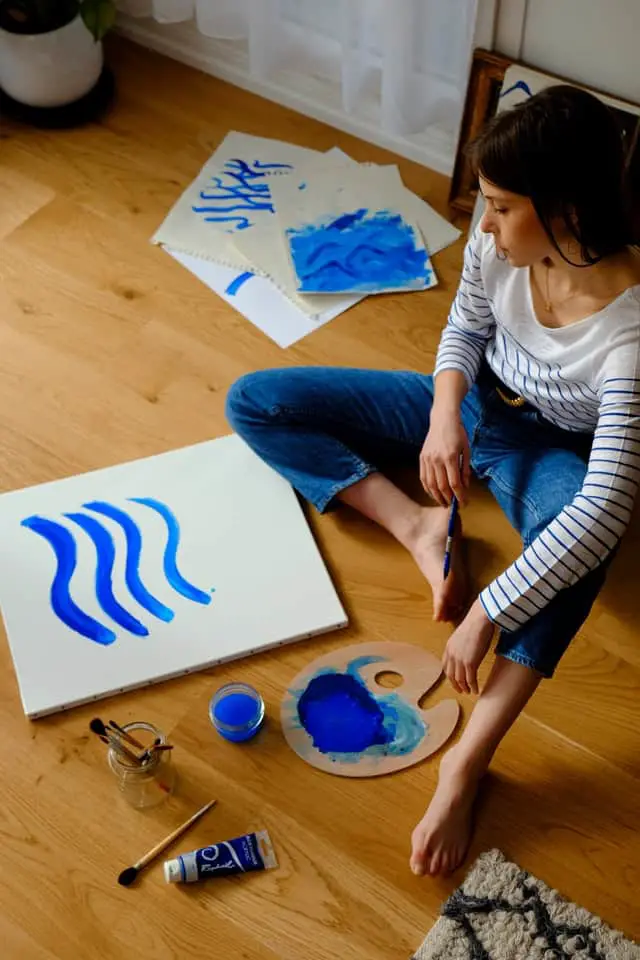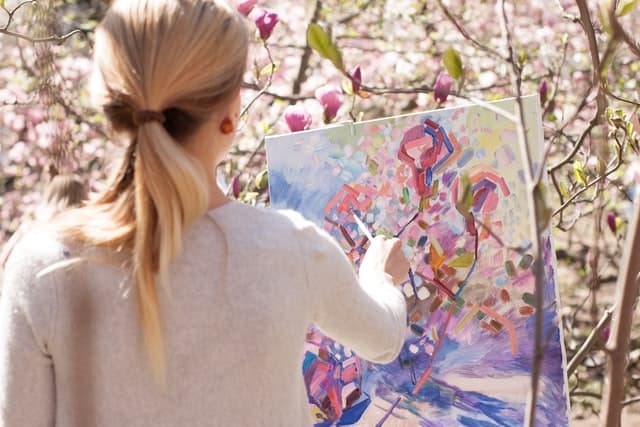Acrylic paint is a beginner-friendly art medium. However, sometimes it can be hard to paint with acrylic paint. Here is why it is hard to paint with acrylic paints.
It is hard to paint with acrylic paint sometimes because of drying fast and giving less time to blend colors. However, to increase drying time or open time you can use a stay-wet palette, slow-drying acrylic paint retarder, or specially formulated slow-drying acrylic paints.
Any art medium at the beginning can be hard to use and a challenge. However, it becomes less difficult and easier when you know the ways to get around the problems.
Is it hard to paint with acrylic paint?
Acrylic paint is not hard to paint as it is the most beginner-friendly painting medium of all. However, it can be a challenge sometimes, especially because of its fast-drying qualities. Most of the time fast drying is a good and distinctive quality of acrylic paints compared to oil paints that take weeks or months to dry.
However, this gives you less time to blend colors. It might frustrate you as the colors are already dry when you try to apply from the palette or mix colors. As to most problems, there are very simple and easy solutions for this which will be further discussed in this article.
Another problem with acrylic paint will be layering. As with most other art mediums, acrylic paint involves building layers. This is the way you create depth in your painting. You will also do the shadows and highlights of the painting in the last layers most of the time.
All of these can be difficult tasks in the beginning even if you are transitioning from one art medium to other or starting as a completely new artist.
Is acrylic paint easy to use?
As I said before acrylic paint is the most beginner-friendly art medium. It is one of the easiest art mediums to use if you knew some ground rules with acrylics.
Acrylic paints dry fast. Therefore you can build up layers very quickly and get done with a painting in about 2 hours. Whereas with oil paints you will have to wait days or weeks for one paint layer to dry and months for a painting to finish.
It is easier to cover mistakes with acrylic paint. If you do not like something in a painting, you can simply apply an opaque paint layer on top and cover the mistake. Some of the opaque colors you can use are titanium white, burnt umber, black, and colors with cadmium pigments such as cadmium red and cadmium yellow.
Unlike watercolors, acrylic paint is painted from darker to light colors. This means your paint bottom layers will be dark and the top paint layers will be lighter. Layering is the primarily used acrylic painting technique. If you know how to build up layers with acrylic paint you are almost there.

Another thing is that you can play with acrylic colors, unlike oil paints as acrylic colors are nontoxic. Acrylic paint can be thinned with water and is easier to clean up. You will not need special thinners to paint with acrylics like with oil paints. However, a wide variety of acrylic mediums are available to create different effects in the painting.
I have written a whole article about why acrylic paint is good for everyone and also the pros and cons of acrylic paint. They will guide you through the most important aspects of acrylic paint in detail.
How do you make acrylic paint easier to paint?
Acrylic paint is easier to paint with if you know how to keep it workable for a reasonable time. This will give you enough time to blend the colors. Also, you will not waste paint just because your paint dried on the palette before even applying it to the canvas.
Following is the list of things you can get to increase the open time or working time of acrylic paint.
- Use a stay wet palette- DIY stay wet palette or Masterson Sta-Wet Palette
- Use acrylic retarder- Golden Acrylic Retarder Additive, Liquitex Slow-Dri Fluid Retarder
- OPEN acrylics by Golden Artist Colors
You can also refer to my article; You can easily learn painting on your own: here is how.
Stay wet palette to keep acrylic paint from drying
A stay-wet palette can be made by yourself very easily. if you want to get something fancy you can go for Masterson Sta-Wet Palette. Following is a video that explains how to make a stay-wet palette for acrylic painting by yourself.
You can keep paints on the stay-wet palette for days and weeks without drying. However, watch out for mold growth if you are keeping acrylic paint on a stay-wet palette for a long time. This helps you reduce the paint waste and make color mixing and using much easier for you.
Acrylic retarder to increase the working time of acrylic paint
Acrylic retarder is another substance you can use with acrylic paint to keep it workable for a long time. Both Liquitex and Golden acrylics have acrylic paint retarders (Golden Acrylic Retarder Additive, and Liquitex Slow-Dri Fluid Retarder).
Mix a little of these liquids with your paint. It will keep the paint wet on the palette for quite some time, no matter what palette you used.
OPEN acrylics to increase the working time of acrylic paint
OPEN acrylic range by Golden is one of the best choices if you are struggling with color blending and keeping them workable for quite some time. OPEN acrylics increase the open time or working time of acrylic paint by 40%.
However, one thing to note is that your OPEN acrylic paints can be less opaque compared to other Golden heavy body acrylic colors.
How to fix acrylic paint mistakes
Fixing acrylic paint mistakes is very easy when compared to fixing acrylic paint mistakes with watercolors. Acrylic paint is very forgiving. It is very easy to wash off any unwanted paints with some water, a paintbrush, and tissue paper when the paint is still wet.
Take some water onto your brush. Dissolve the unwanted acrylic paint strokes by rubbing them with wet paintbrush bristles. Once the paint has dissolved use tissue paper to remove the paint.
When the paint is already dry, it is permanent on the canvas or other porous surfaces. It cannot be dissolved in water. In this case, you can simply paint over the mistake with an opaque acrylic color like titanium white, burnt umber, black, or other cadmium pigments like cadmium red and cadmium yellow.
I have written an article series about common acrylic paint questions and answers: part 1 and part 2. You can find answers to questions like this in the articles even before you face them.
Way to level up your acrylic painting skills
You might be frustrated about not getting better at acrylic painting and what you should be doing to level up your acrylic painting skills. There are a few things I think you should be doing to level up your painting skills. I will also share some ideas from other artists as well.
Follow step-by-step tutorials
When you are starting out painting it is harder to figure out most painting steps by yourself. Therefore step by step tutorial will help a lot. Go for these tutorials on Youtube. One of the youtube channels I recommend is Michelle the Painter.
Once you have been following the tutorials you will get a good understanding of the acrylic painting techniques. As you paint along with these step-by-step tutorials you will learn more and level up your painting skills.
In the beginning, it will be important to follow these tutorials step by step exactly as it is. This way it is easier to create beautiful artwork and keep yourself motivated. However, after following these tutorials for a while you will need to add touches of your creativity to the artwork.
Unleash your inner artist
Adding the touch of your creativity to the art is important to make it a unique beautiful piece of work. In the beginning, this might be difficult to do. The best way to add your creativity to the paintings, in the beginning, is to change the paintings from the tutorials you are following to your liking.

Also, you can refer to reference photos and create paintings of your own. One important thing to learn is not to try to be too realistic with the reference photos. Take them as a reference and paint what you see in them. Observe the nature of how things are; lighting, shadows, highlights, and details.
You can snap photos when you are on vacation and use them as a reference. Make sure to take close-up photos to see the details of things better. Eventually, you will better remember details and the natural composition of things better.
Important pieces of advice…
Here I want to add some important pieces of advice given to me by other artists.
Remember that old saying, “Patience is a virtue”! Certainly true with painting. Don’t expect perfection right away. Learn from your failures, and try to be positive about them. Remember, it’s only a painting. Don’t agonize over what you consider a failure, just paint over it all and start again. Like learning to read, it’s a process!
Claire Amirault
The following quote highlights the importance of unleashing your inner artist and how to go about it.
I finally understood and internalized that I would never paint the same as any other person and my interpretation will be uniquely my own. That’s when my painting improved and I gained confidence and really started to enjoy painting. I hope you find this in your journey!
Denise Felton-Pagonis
Conclusion
Acrylic painting is one of the most enjoyable and soothing things to do. It is the best art medium to go for as a beginner, but it is used by many professional artists as well. The main caveat of acrylic paint is its fast-drying ability. You can get around that from the methods I have mentioned in the article. If you follow these in your acrylic paintings, it will not be hard and most importantly you will enjoy the process.


